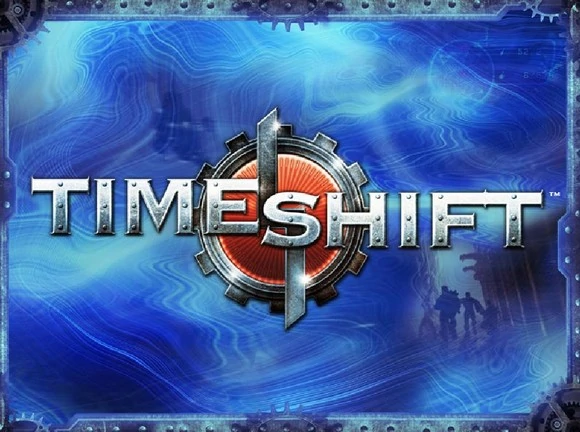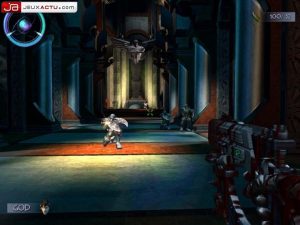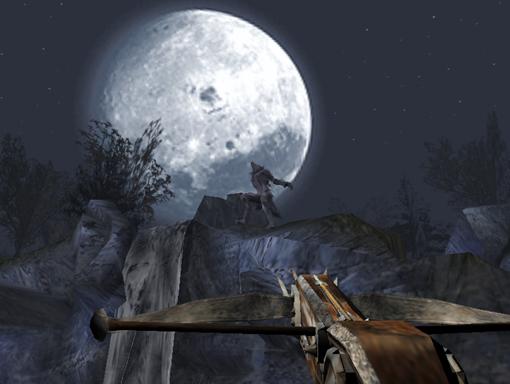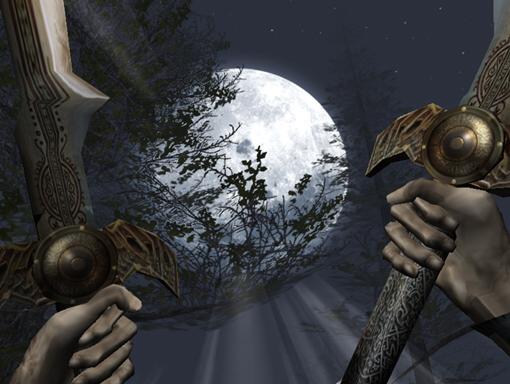TimeShift is a futuristic First-Person Shooter released in 2007 for the PC, Xbox 360 and Playstation 3, developed by Saber Interactive and first published by Atari, then, by Sierra Entertainment.
TimeShift‘s plot revolves around a secret program aimed at designing two time shifting suits. One is stolen by the doctor Aiden Krone, the main villain, and you, wearing the other, must go find it. Following him backward through time to 1939, player discovers a dystopian sci-fi alternative past with Krone as the supreme ruler.
Its key feature is the player’s ability to control time: slowing, stopping and rewinding it. This allows many possibilities during gunfight as well as solving specific puzzles.
The game’s development was pretty messy. It was first revealed in February 2004 under the title of Chronos, and was planned for the PC, Xbox and Playstation 2, using the in-house engine of Saber Interactive, the Saber3D Engine. As we can see on the screenshots for this version, it was using the same HUD as previous Saber’s game: Will Rock. Here is what we could read on French website Jeuxactu:
Known for having developed Will Rock, Saber Interactive is currently working on a new project called Chronos. This will be an FPS based on the same engine as Will Rock’s (which is also a homemade engine). If we don’t know anything at the moment about the scenario and the gameplay of the game, Saber Interactive has nevertheless shared some images on their official site. Planned on PC, Xbox and PS2, Chronos should probably be released later this year in the United States, as soon as a publisher is found.
The project resurfaced in October of the same year when HomelanFed announced that Atari was going to be the publisher:
A check of Atari’s official web site reveals some titles of games that have not yet been officially announced. The PC section shows a listing for Civilization IV, which is most likely the next game in the long running and popular strategy game series. Other unannounced games listed include three identified as “action” titles with the names Chronos (PC-Xbox), Enemy In Sight (PC-Xbox) and Rat Race (PC). Besides the titles and the game platforms there is no other info available on these games.
In January 2005, Atari renamed Chronos as TimeShift and shown it to Gamespot. Throughout the entire 2005 year, the project was showcased here and there at various occasions. However, in April 2006, Atari sold the game to Vivendi Universal Games, owner of the Sierra Entertainment’s brand, as we can read on Gamedeveloper:
Officials from Vivendi Universal Games have confirmed, via a pre-E3 press showing, that time-bending PC and Xbox 360 first person shooter title Timeshift will now be published by VU Games, rather than original publishers Atari. Although representatives from Atari have not commented on the change, the game was initially scheduled for a May release by the company, but no longer appears on Atari’s schedules. Vivendi officials were unable to provide further details at time of press, indicating only that the game currently does not have a scheduled release date.
The storyline alongside various characters were rewritten or removed, the only exception being the doctor Aiden Krone, formerly named Ivan. Here is what we can read about these former characters on GameGossip:
Colonel Michael Swift
Colonel Michael Swift (recently retired) has a unique combination of brains and brawn that have helped him to rapidly rise to the top ranks of the Air Force. An all-state running back in high school, Swift passed up on athletic scholarships from some of the country’s best universities to join the Air Force Academy where he majored in military strategic studies. After graduating from the Academy at age 21, Swift spent ten years as a combat and recon pilot, flying thousands of sorties. In the year 2004 during a secret mission he was shot down over hostile territory. He spent three months navigating the treacherous terrain of the enemy’s land, avoiding capture and battling the elements before successfully reaching the border of an ally. His resurfacing became the stuff of legend and the Air Force soon promoted him to the rank Colonel. He soon became a specialist in the research and development of advanced weaponry for future combat. Upon the death of his wife he retired from active duty and became a full-time father.
When a government agency initiated the testing of the Quantum Suit and the Chronomicon – a highly publicized event – they chose Swift to perform the experiment as he was the only candidate with the proper mix of DNA, brains and strength to perform he job. After initially declining the offer, the tragic death of his daughter Emma causes him to reconsider.
Professor Ivan Krone
Professor Ivan Krone was born in 1947. Krone’s father, Nicholas, was a scientist who worked in the US Patent Office in Washington DC.
In 1955 Krone’s parents were killed in an accident. With no known relatives Krone was transferred to an orphanage where he spent the rest of his youth. He became highly anti-social and isolated himself from the other children in the home. Krone escaped reality by embracing the study of science. For the next decade he devoted all of his time poring over the works of the world’s great physicists, from Newton to Einstein to Feynman to Hawking. Krone soon began to see himself as the next in line among the kings of physics.
By the age of 17 Krone was accepted into the Technology Institute where he studied for the next 10 years before receiving his doctorate in Applied Physics at the age of 27. Upon graduation he took a position in the Institute as an associate professor. He began to delve seriously into the study of time travel and time control. By the turn of the century, Krone had developed a device that he was convinced would allow for limited time control functionality. He sought out students interested in participating in an experiment to test the device. One student volunteered. The test proved disastrous – the device exploded during the experiment and the student was killed.
An investigation followed the tragedy and Krone was found guilty of criminally negligent homicide. He was sentenced to an unusually harsh prison sentence. For the next decade-and-a-half Krone’s obsession with time control grew even stronger. He feverishly devoted himself to its study during his long tenure in prison. Upon his release he had a host of ideas ripe for testing, but he couldn’t find a way to get them funded. He was rejected and shunned by the academic community and mocked for his obsession with the study of time. Krone was left to find a way to fund his studies on his own.
For the next decade Krone worked zealously. He spent days working as a janitor in a local college and nights secretly working in the school’s labs. By the turn of the century Krone had made a startling breakthrough. While he had not yet discovered a way to travel in time, he created a device that allowed for limited control of time. Word leaked to the public of this invention and the government quickly assumed control of the device in the name of the national interest. Krone was devastated. He had worked his entire life to come to this moment and now the government had usurped control over his project. The government promised him compensation and guaranteed him the right to continue to develop the project. He reluctantly agreed, all the while resentful of the government for scorning him and then assuming control over his life’s work. It was in this environment that Swift was chosen to test the Quantum Suit in November of 2007.
Jasmine Lin
Jasmine Lin is Ivan Krone’s assistant on Project TimeShift. She has a passion for what she does, and it has taken complete priority in her life – above family, a vacation, or a relationship. She is especially optimistic about Krone’s project…but she has a chip on her shoulder due to having been passed over multiple times within her career progression because of both the male-dominated nature of the military and the innate bureaucracy of the government itself. Additionally, she has been given the awkward and stressful task of gaining the commitment of the notoriously obstinate Colonel Swift, who is ironically the ONLY man found within the military (past or present) to be able to take part in the project due to his unique DNA.
General Bruce Mitchell
General Mitchell is Project TimeShift’s military overseer. While Professor Krone is the director—and the brains—behind the project, Mitchell unquestionably holds the purse strings. It is Mitchell who suggests Swift’s involvement in the Project, as his ex-superior. Enormously competent and meticulous to a fault, Mitchell cares only for the men under his command and his duty to his country.
Emma Swift
Emma is Swift’s 5 year-old daughter. She is the only family he has, and is the reason he initially turned down the chance to be involved in Project TimeShift in the first place. Her death in an accident that destroyed her school bus haunts Swift even as he agrees to take part in the Project.
Some famous actors were initially going to voice characters in the game. Revealed in July 2006 by Gamespot, Dennis Quaid was the voice of Michael Swift and Michael Ironside voiced Dr. Ivan Krone:
Today, Vivendi Games announced that Michael Ironside has joined the voice cast of TimeShift, the sci-fi shooter the publisher recently acquired from Atari. Ironside will play Doctor Krone, one of the scientists developing the time-travel technology at the center of the game’s storyline.
Joining Ironside is one of Hollywood’s more recognizable leading men. Dennis Quaid, whose 20-year career has spanned the 1980s, ’90s, and ’00s, is also joining TimeShift’s cast. It will be his first game project and will see the aging heartthrob play Colonel Michael Swift (Ret.), a former test pilot who becomes the world’s first “chrononaut,” or time traveler.
Rounding out the cast is character actor Nick Chinlund, who will play General Mitchell, director of the game’s time-travel project. Though not a marquee name, Chinlund has appeared in many movies familiar to gamers, including Chronicles of Riddick and Training Day. Chinlund has had guest spots in several high-profile TV series, including The Sopranos and Desperate Housewives.
In the final game, none of the work done by these actors were retained, as characters Michael Swift and Bruce Mitchell were both entirely removed, and character Ivan Krone rewritten. Storyline was also a bit modified, but remains the same in general:
The storyline basically was as follows: Michael Swift, the protagonist, volunteers for a time-travel experiment, under the direction of scientist Dr. Ivan Krone. Swift travels back to 1911 and tampers with the past in some way. Upon returning to the present day, the entire world has changed and Krone is now an evil dictator ruling over a 1984-but-cartoony-esque United States.
Following the acquisition by Vivendi Games, TimeShift was pushed back for the end of 2007 and decision to make a complete overhaul of the project was taken. In April 2007, director of product development Kyle Peschel, explained everything that happened on Shacknews:
“So Sierra pulled me in the office last year–with seven bugs left to fix on TimeShift–and said, ‘If we gave you a year, what would you do with that?’
I said, ‘Are you fucking kidding me? I’ve got seven bugs, let’s put the fucking thing out tomorrow. I’m sick and tired of fucking crunching. I can’t handle hundred hour weeks for another year.’ And Martin Tremblay, who had recently arrived, said, ‘No, Kyle, I really believe we can do something greater than what we’re doing now. What would you do?’
“Well I said, ‘I’d scrap the physics system, get rid of this Meqon and put in Havok. I’d kill off the first four levels of the game, because we made the classic video game mistake of doing the beginning first and the end last, and the end is great and the beginning is weak. All these Full Motion Videos we paid for, I want to get rid of them. I want to get rid of the story, I want to get rid of the style guide, I want to get rid of the weapons, I want to get rid of the menus, I want to get rid of the HUD, I want to get rid of the suit. I want to get rid of the main character; people aren’t identifying with him.’ I just went down this list. I was kind of going after that list so aggressively that I was kind of hoping people would say to just release the game tomorrow, and then I could be done with it. But he goes, ‘Okay. Let’s do that.’
TimeShift has switched publishers (from Atari to Vivendi subsidiary Sierra), switched platforms (from Xbox and PC to Xbox 360, PC, and PS3), switched visual styles (from steampunk to gritty oppressive future), and switched innumerable control- and design-related decisions, but it has not switched its producer. Peschel described to me how he started on the project back at Atari, and how he managed to stick with it when it was dropped as a result of that publisher’s well-publicized tumultuous financial situation.
“TimeShift was picked up almost four years ago almost as a value title,” he explained. “When it was originally picked up by Atari, I had just come off of some other first person shooters. It was kind of opportunistic–let’s take a chance on these guys in Russia. So I sat down and started looking at the game said, ‘You know, I think we could really do something with this,’ provided we really built the mechanics and made it not gimmicky, focused on an interesting art style like steampunk–set it apart from the myriad of things. So we started rolling with it, and got about done with the Xbox [version], and I sat down with [then Atari CEO] Bruno Bonnell and all the execs at Atari, and they said, ‘So, Kyle, can you make this game for 360?’ I’m like, ‘What, am I a fucking genie now?’ They say, ‘No, seriously, it’s for 360 now.’
“I say, ‘Okay, I’m sure we can get that out.'”
That was to be the first time the game would undergo large-scale redevelopment. Soon, however, Atari’s funding started to dwindle in the face of falling revenues, and in January 2006 the team was pressured to get a demo released quickly. Internet response illuminated some of the game’s major issues, some of which were a result of the game being quickly ported up to target then-current hardware, and some of which went as deep as the game’s perhaps poorly planned visual style.
“When you get something in that many hands, you listen to the feedback. I’m making games for guys like me, not for corporate America. I mean, I work for corporate America–I don’t want to sell it like I’m the fuckin’ hero of gamers everywhere–but I’m cognizant of what people are saying. I was on Shack reading the comments and, reading between the lines, people were saying basically, ‘I really like some of what they’re doing, but this steampunk shit is ass. Look at this fucking knuckleduster thing, what the fuck is that? It’s all confused.'”
Soon after, Atari announced that it would be shedding much of its development to help reduce expenditures. TimeShift was put up on the auction block, and Peschel quit his job to go work for Vivendi’s Sierra Entertainment label. “Within a day,” he recalls, he was approached by management with the possibility of Vivendi acquiring TimeShift from Atari and reassigning him to the project. At the time, Peschel was working under industry veteran Drew Markham, who founded Gray Matter Studios, designed Xatrix’s Kingpin: Life of Crime, and produced Gray Matter’s Return to Castle Wolfenstein. Markham saw, as Peschel had when the game was first signed by Atari, that TimeShift had more potential than it was demonstrating, so Peschel went back and started rethinking major aspects of the game.
“I changed the storyline up at the last minute, and that’s when we brought in [voice actors] Dennis Quaid and Michael Ironside and all those guys,” he recounted. “A funny thing happens when you rewrite the story: you pay attention to everything. I was thinking, ‘Fuck, X isn’t working, Y isn’t working, I wish I could do this.'”
That was when, at seven bugs away from completion, Peschel was called into Sierra’s offices and was told that he had another year. The original steampunk theme was dropped and replaced by a grittier, darker, more desolate future. The main character was redesigned from a muscle-bound action hero to a more faceless protagonist in a full body suit, into which Peschel hopes players will project themselves.
It must be stated that TimeShift’s visuals have come a long, long way since the game was shown in demo form last year. Since that point, it went through an overhaul to bring it up to speed for Xbox 360, but Peschel noted that even then the game had a great deal of legacy geometry and textures, and did not feel up to par with modern shooters. It was not until development was revamped again and the entire visual style scrapped that the game began to look truly new.
After its release, TimeShift has received mixed to positive reviews by the press. In December 2017, VentureBeat revealed during an interview of Matthew Karch, Saber’s CEO, that a spiritual sequel called Timebender was in development:
As Saber continues to work on Quake Champions, it’s also working on other projects, most notably a follow up to its 2007 time-manipulation shooter: TimeShift. Saber hasn’t officially announced it yet, but it’s in development. It’s something of a passion project for the studio. (…) Of course, it can’t be called TimeShift 2, since Activision still owns the rights, so instead it’s a spiritual successor. It will be a new story with a new name, but the most important elements, like the time manipulation, will be returning. (…) As for the new name, nothing is set in stone, but Karch has already registered ‘Timebender’.
According to some information made available from the e-book Advances in Computer Entertainment Technology: 14th International Conference, Timebender was going to be multiplayer only. However, according to this site, it seems that the project could have been dropped as the use of the Timebender trademark entered in the status “abandonned” in November 2018.
As noted by Liqmatrix the Atari PC seven level single player beta is available at this link: https://archive.org/details/
Thanks to John Paul, Liqmatrix and Gerror for the contribution!
Article updated by Daniel Nicaise
Chronos images:
TimeShift Atari’s version Images:
Gameplay videos from the 2006 demo:
Michael Ironside’s interview:
Nick Chinlund’s interview:




